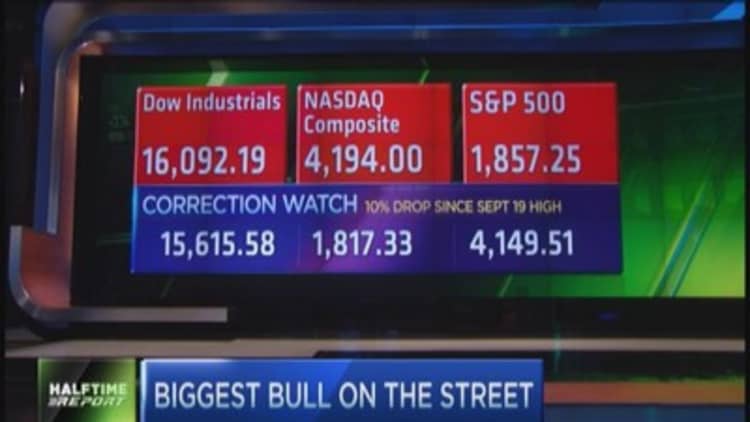
Stocks shook off steep losses, as small caps and transports moved higher Thursday, but strategists say the selloff will likely continue until investor psychology changes and they feel more pain.
"I think there's potentially more downside. My target on the S&P is around 1,800, the Nasdaq is around 4,000 and the Dow is 15,400," said Paul LaRosa, technical strategist at Maxim Group.
LaRosa said the market signaled a pending selloff when the small-cap Russell 2000 failed to confirm the September highs made by the Dow and S&P 500, and instead moved lower. The Russell bounced slightly Thursday, as it did late in Wednesday's session, and is now off about 11 percent from its July 1 high.
Stocks opened sharply lower Thursday, with the Nasdaq entering correction territory with a 10 percent decline from its highs. The Dow reversed much of its steep losses, and the S&P turned positive briefly. The Russell 2000 was trading higher, with a gain of 0.7 percent.
"We're getting close ... I think we're going to have to test 1,820 (on the S&P 500) where we hit yesterday. Maybe it's not today. It might be over the next few weeks. My guess is we fail and go below 1,800," said James Paulsen, chief investment strategist at Wells Capital Management.
The Nasdaq was the first major index to enter double-digit correction territory since April 2011, as the market's pattern has been to see relatively shallow pullbacks. The Russell fell into correction territory on Oct. 1.
The S&P 500 would be in correction territory it if were to hit 1,817, 10 percent below its intraday high.
Read MoreDow reverses losses, S&P positive
"I still think it has to get scarier because you still have people thinking this is an opportunity too much," he said. Paulsen said he would recommend buying on days when the market sells off but cautiously. "When it's over, I'll be scared," he said.
Paulsen has expected the S&P to end the year at about 1,850, anticipating the market to react to an overheating from too much Fed stimulus.
But instead the market has been reacting to the Fed and the fact it is stepping away from quantitative easing at a time when investors are worried about a global growth scare.
LaRosa said the market was overvalued. "The backdrop is not indicative of a market that could sustain the levels we saw," he said, adding the environment is also not like it was during the financial crisis.
"I don't think it's a 2008 situation. It's much different. Companies are in better shape. The financial system is in better shape. The economy is OK," he said.
LaRosa said he was asked by investors if the market capitulated when the S&P hit 1,820 on Wednesday. "It's possible this is a low, but I think the probabilities are there are more downside moves. I think if people have cash, they should look to slowly get in."


